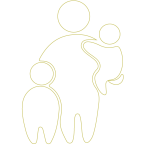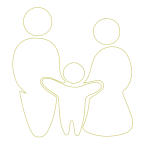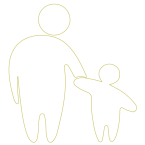Make the Connection - National Suicide Prevention Month
September is National Suicide Prevention Month. Many people become uncomfortable discussing suicide. It’s a topic surrounded by stigma and fear. But the more suicide is talked about, the more society can do to help prevent it. Center For Family Services invites you to take action this September by learning how you can be part of the change and help prevent suicide in your community.
Let’s start with the statistics. According to the American Foundation for Suicide Prevention:
• There are about 132 suicides per day in the US
• Suicide is the 2nd leading cause of death for ages 20-34
• It is the 3rd leading cause of death for ages 10-19
• And the 4th leading cause of death for ages 35 - 44
• 54% of all firearm deaths were suicides
The statistics are heartbreaking. They are comprised of someone’s child, partner, a best friend, a grandchild, an individual who was in such despair that they ended their lives by suicide. The survivors – the family and friends - left behind to sort through their memories, trying to determine what happened, and wondering if they were somehow to blame.
There are multiple websites devoted to suicide prevention and they all touch upon the same theme: connection. The power of human connection. It is real, and it can change lives. Each, and every, one of us has the power to change a life. Sometimes the smallest acts of kindness can save a life.
988 Suicide and Crisis Life Line’s #BeThe1to campaign is an important resource that can help you take action to prevent suicide. These five simple steps promote hope and recovery.
ASK
There is no simple answer to why someone might consider suicide as an option to end their suffering. Individuals contemplating suicide may find themselves having difficulty coping with life’s adversities, such as the loss of a loved one, having financial problems, job loss, lack of housing, legal issues, social isolation, bullying, prejudice, feelings of being a failure. It may involve mental health issues, abuse, trauma, chronic pain, or substance use.
The National Institute of Mental Health identifies behaviors which may mean that someone is considering suicide:
• Talking about wanting to end their lives
• Feeling trapped or humiliated
• Feeling as if they are a burden to others
• Feeling sad, anxious or full of rage
• Being in intense emotional or physical pain
• Withdrawing from people and activities
• Giving away prized possessions
• Increasing the use of drugs or alcohol
Checking in with someone who may be having thoughts of suicide does not increase the likelihood that the person will act on those thoughts. Actually, just the opposite. According to the National Alliance on Mental Illness (NAMI), asking if a person is considering suicide may prove to be helpful. We also know that when people consider suicide it is because they want to end their suffering. They may feel helpless, and unable, or unworthy, to reach out for the support they so desperately need. Just by asking, by checking in, by supporting a friend, co-worker or family member, you are offering a lifeline.
BE THERE
By dropping all judgments, and really listening to someone, we may help the individual gain perspective, and reduce feelings of being overwhelmed, trapped or hopeless. Find out what they really need. What would be a reason for them to want to continue to live? Without imposing your own views, really hear what they are saying.
KEEP THEM SAFE
Reducing access to lethal means is imperative. Remove the guns, remove the pills. Firearms, in particular, are more lethal than other means. According to research from the Harvard T.H. Chan School of Public Health, 85% of suicide attempts with a firearm prove to be fatal. Compare this to most other methods, which have a fatality rate below 5%. Being able to access a firearm in the desk drawer is a much greater risk to a person contemplating suicide, than if the gun was removed from the home, or safety locked away. Placing a temporary distance between the individual at risk and the pills, firearms or other lethal means can save a life.
HELP THEM STAY CONNECTED
Take the time to assist the person at risk to develop a support network of people they can turn to when in crisis. This could include helping them create a safety plan, and identifying who they can contact for help, such as a trusted family member, therapist, or the local hospital, or other community resource. Here are some resources to consider:
• Local county screening centers
https://www.state.nj.us/humanservices/dmhas/home/hotlines/MH_Screening_…
• 988 Suicide & Crisis Lifeline - Available 24/7 for confidential support.
• “Suicide Safety Plan” app - Free on the App Store or Google Play
• Your local mental health association (https://www.mhanj.org/)
FOLLOW UP
It’s all about connection. Once you’ve helped someone develop a link to supports, check in and see how the person is doing. Call, send a text, email or stop in to see them. Is there anything else you can do to help? It may not seem like much, but by reaching out you may reduce their risk of suicide.
Suicide prevention may seem like a daunting task. Often, loved ones, or close friends, don’t want to make a false move – they are afraid they will do more harm than good. But the good news is that research tells us that we as individuals can make a difference. The more you know, the more lives we can save. Making these small connections can make a huge impact on someone’s life. Be the one to be there. Be the one to save a life.
References
American Foundation for Suicide Prevention, https://afsp.org/
Harvard T.H. Chan School of Public Health, https://www.hsph.harvard.edu/
National Alliance on Mental Illness, https://www.nami.org/home
National Institute of Mental Health, https://www.nimh.nih.gov/
https://www.nimh.nih.gov/sites/default/files/documents/health/publicati…;
The 988 Suicide & Crisis Lifeline, https://988lifeline.org/
For more information watch this video that expands on the # BeThe1to steps: https://www.bethe1to.com/watch/



